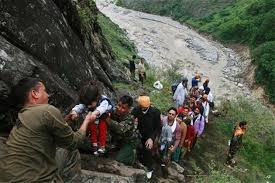
The state has been divided Geographically in three natural divisions:-
Great Himalayas
Middle Himalayas
Hills of shivalik and Doon
Great Himalayas :-
This natural sub-division is known as himadri .this part extended 50km in width whose most of the mountainranges are 4,800 to 6,000 metre high.many glaciers are found in this part.and the sources of Bhagirathi , Alakhananda , and Yamuna etc.
The soil of this part of Himalayas is made from the dregs of stones which is changed into valleys due to erosion.
Famous mountains ranges of this region are :-
Nandadevi (7,817 m)
Kamet ( 7,756 m)
Bander punch ( 6,315 m )
Mara ( 7,273 m)
Nandadevi eastern ( 7,434 m)
Chaukhambha( 7,138 m)
Trishul ( 7,120 m )
Doonagiri ( 7,066 m )
Panchachuli (6,904 m)
Nandakot ( 6,861 m)
Badrinath ( 7,138 m)
Besides these kedarnath,gangotri,and yamunotri etc.glaciers whose heights are more than 6000 metres. These regions are coldest place because all the mountain ranges are always covered with snow.the great Himalayas are made up of folded ranges in the shape of feathers.river Ganga drainage system ,Yamuna drainage system,black river drainage system are present in this part .river Ganga drainage system is present in almost all part this area except western part. Rainy season started in this part the month of june and continues to th middle of September and its quantity is from 100 to 200 cm.it rains nominal in the winter season.a small quantity of rain falls in the form of snowfall. Rain in summer is monsoonal type but is doesnot go in the north because it can not cross the mountains.
Sub-tropical zonal evergreen florae are found in this part of Himalayas.tree of sar,fir,saal,chir,and Buihes and grasses etc. florae are only found in more high areas not found in lower region of valleys of mountainous areas. Agriculture is done only in lower part of valleys.
Middle Himalayas:-
Its situated in the south of Greater Himalayas.districts of Almora, Uttarkashi, Garhwal ,Tehri ,Nainital etc comes in this area. Mountain range are generally 3000 to 4000 metres high which is parallel to the chief ranges extended from east to west .
The middle Himalayas is very new part-according to this surface structure in which sedimental rocks are present.these sedimental rocks are seen in the form of plain fields in the areas which are nearabout 2000 metres high.intense cold in the middle Himalayan area in the winter. The temperature falls below the zero degree Celsius.as a result ,snow also falls whereas the weather in summer is pleasant.average temperature of this season remains – between 18 degree celcious and 20 degree celcious.it rains heavily in the month of july due to summer monsoon. Its quantity raises upto 150 cm. due to this ,the water level of rivers rises in rainy season. Tourists comes in middle Himalayas in summer because the season of this part is colder than the other parts. 50- per part of this region are covered with forests. The tree of chir,fir,sal,deodar etc. are mostly found in this area. These forests are
very useful according to economical points of view because the woods of these forests are used for fourniture making.
Hills of shivalik and doon :-
Also known as ‗foot of a mountain ranges‘ because these hills are situated in the south of Himalayas and comparatively of low height. The hills of shivalik re very narrow from north – west to south-east and extended in the down side. Primarily these hills are extended parallel to the Himalayas.south almora,middle of nainital and dehradun districts come under shivalik area which are situated at the height of 750m to 1500m.these hills are quite different from Himalayas according to surface structure.there are less high hills in the south of shivalikhills and many flat valleys are situated in the middle of small Himalayas.these valley are called ‗Doon‘. This valley of dehradun district is very important which is spread from 25 to 35 km im width and 350 to 750 metres in height. The valley of kota doon,patali doon,Kothari doon,kiryana doonetc are situated near this valley.
Summer season of this region are hotter then that of Himalayan-mountainous region.temperature remains from 28 degree to 33 degree celcious,temperature in winter season is remains from 4 degree to 9 degree celcious.the quantity of rain is from 150cm to 220 cm . the weather is very pleasant in the areas of Mussourie,ranikhet,chakrata,nainitaletc.peoples comes to visit terrain region,natural florae are found in abundance in this region because trees of sheesham,amla,saal,chir,deodar,bamboo,oak,birch etc are found in abundance .
GLACIERS :-
Gangotri ( uttarkashi)
Milaan ( pithoragarh)
Poting ( ―)
Nabhik (―)
Pindari ( bageshwar )
Sundardhunga (―)
Kafani (―)
FAMOUS VALLEYS :-
Shringakantha( uttarkashi- hp)
Thaga-la ( uttarkashi-tibet)
Muling-la-5669m( uttarkashi-tibet)
Bhara(chirbatia or dugari)-la 5608m( chamoli-tibet)
Neeti-5044m( chamoli-tibet)
Barahoti (chamoli – pithoragarh)
Kungari-wingari ( chamoli-tibet)
Darma (pithoragarh-tibet)
Lipulekh ( ―)
Trelpass ( bageshwar-pithoragarh)
- UKPCS Mains Tests and Notes Program
- UKPCS Prelims Exam 2024- Test Series and Notes Program
- UKPCS Prelims and Mains Tests Series and Notes Program
- UKPCS Detailed Complete Prelims Notes
